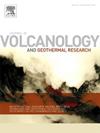Melt embayments record multi-stage magma decompression histories
IF 2.4
3区 地球科学
Q2 GEOSCIENCES, MULTIDISCIPLINARY
Journal of Volcanology and Geothermal Research
Pub Date : 2024-10-23
DOI:10.1016/j.jvolgeores.2024.108211
引用次数: 0
Abstract
Over the last decade, the melt embayment has proven its merit as a robust petrological tool capable of recording magma decompression rates for explosive eruptions. However, the models developed and applied to extract this information from embayments have not accounted for the complexity and nonlinearity of magma flow in the conduit. We present Embayment Decompression in Two Stages (EDiTS): a numerical model for extracting magma decompression rates from measured volatile diffusion profiles preserved in crystal-hosted embayments, approximating magma acceleration using two constant-rate decompression paths. This model solves for three unknown parameters: initial (deeper) and final (shallower) decompression rates, as well as the pressure where a transition occurs. We successfully benchmark EDiTS against existing numerical diffusion models, and use controlled multi-stage decompression experiments on natural quartz-hosted embayments to test the ability of our model to recover known decompression paths. We find that EDiTS is able to closely approximate the known two-stage path in the mixed-volatile (H2O + CO2) experiment, while a constant-rate modeling approach is unable to simultaneously fit H2O and CO2 gradients. However, in the H2O-saturated experiment, there is no unique solution to the resulting gradient, with both constant-rate and two-stage models reproducing the measured profile, and EDiTS notably overestimating the known total ascent time by several hours. Using decompression experiments, we show that constant-rate models can provide misleadingly good fits to embayment H2O gradients produced by more complex decompression histories, and thus the measurement and modeling of multiple diffusing species, when available, can provide crucial constraints. We then apply EDiTS to re-evaluate mixed-volatile embayment datasets from explosive silicic arc and caldera-forming eruptions from five volcanic centers (Yellowstone, WY, USA; Valles, NM, USA; Long Valley, CA, USA; Taupo, NZ; Mount St. Helens, WA, USA). In contrast to the minutes to hours of total ascent time extracted from embayment volatile profiles using constant-rate models, our two-stage model resolves slower initial ascent times that span 3.5–11 h. Final ascent rates are 1–2 orders of magnitude faster than the initial extracted rates, in agreement with theoretical conduit flow model predictions. Reassessment of embayments from the May 18th, 1980 eruption of Mount St. Helens results in an initial stage of ascent consistent with the timing of magma arrival at the surface from the seismically-inferred storage region (7–9 km) ∼3.5 h after the initial blast, and a final stage of ascent (<1–5 min) in close agreement with time-integrated bubble number densities. Our combined numerical and experimental results, and reevaluation of natural datasets, suggest that, with the application of advanced models, the melt embayment can provide a more nuanced picture of magma decompression timescales from the deep conduit to the surface.
熔体蕴藏记录了多级岩浆减压历史
在过去的十年中,熔融栓塞已经证明了其作为一种强大的岩石学工具的优点,能够记录爆炸性喷发的岩浆减压率。然而,为从栓塞中提取这些信息而开发和应用的模型并没有考虑到岩浆在导管中流动的复杂性和非线性。我们提出了 "两阶段内湾减压(EDiTS)":一个从晶体托管内湾中保存的实测挥发物扩散剖面提取岩浆减压率的数值模型,利用两条恒速减压路径近似岩浆加速。该模型求解了三个未知参数:初始(较深)和最终(较浅)减压率,以及发生转变时的压力。我们成功地将 EDiTS 与现有的数值扩散模型进行了比较,并在天然石英矿床堤坝上进行了多级减压实验,以测试我们的模型恢复已知减压路径的能力。我们发现,在混合挥发物(H2O + CO2)实验中,EDiTS 能够接近已知的两阶段路径,而恒定速率建模方法则无法同时拟合 H2O 和 CO2 梯度。然而,在 H2O 饱和实验中,所产生的梯度并没有唯一的解决方案,恒定速率模型和两阶段模型都能再现测量结果,而 EDiTS 则明显高估了已知的总上升时间数小时。通过减压实验,我们发现恒定速率模型可以误导性地很好地拟合由更复杂的减压历史产生的沼泽地带 H2O 梯度,因此,如果可以获得多个扩散物种的测量数据和模型,就可以提供重要的约束条件。然后,我们将 EDiTS 应用于重新评估来自五个火山中心(美国怀俄明州黄石公园、美国新墨西哥州瓦勒斯、美国加利福尼亚州长谷、新西兰陶波、美国华盛顿州圣海伦山)的爆炸性硅弧和火山口形成喷发的混合挥发性栓塞数据集。与使用恒定速率模型从沼泽挥发剖面提取的数分钟至数小时的总上升时间相比,我们的两阶段模型解析了跨越 3.5-11 小时的较慢初始上升时间。对 1980 年 5 月 18 日圣海伦火山喷发产生的栓塞进行重新评估的结果表明,上升的初始阶段与岩浆从地震推断的贮存区(7-9 千米)到达地表的时间一致,即初始爆炸后 3.5 小时;上升的最后阶段(1-5 分钟)与时间积分气泡数密度非常一致。我们结合数值和实验结果以及对自然数据集的重新评估表明,通过应用先进的模型,熔体栓塞可以提供从深部导管到地表的岩浆减压时间尺度的更细致的图景。
本文章由计算机程序翻译,如有差异,请以英文原文为准。
求助全文
约1分钟内获得全文
求助全文
来源期刊
CiteScore
5.90
自引率
13.80%
发文量
183
审稿时长
19.7 weeks
期刊介绍:
An international research journal with focus on volcanic and geothermal processes and their impact on the environment and society.
Submission of papers covering the following aspects of volcanology and geothermal research are encouraged:
(1) Geological aspects of volcanic systems: volcano stratigraphy, structure and tectonic influence; eruptive history; evolution of volcanic landforms; eruption style and progress; dispersal patterns of lava and ash; analysis of real-time eruption observations.
(2) Geochemical and petrological aspects of volcanic rocks: magma genesis and evolution; crystallization; volatile compositions, solubility, and degassing; volcanic petrography and textural analysis.
(3) Hydrology, geochemistry and measurement of volcanic and hydrothermal fluids: volcanic gas emissions; fumaroles and springs; crater lakes; hydrothermal mineralization.
(4) Geophysical aspects of volcanic systems: physical properties of volcanic rocks and magmas; heat flow studies; volcano seismology, geodesy and remote sensing.
(5) Computational modeling and experimental simulation of magmatic and hydrothermal processes: eruption dynamics; magma transport and storage; plume dynamics and ash dispersal; lava flow dynamics; hydrothermal fluid flow; thermodynamics of aqueous fluids and melts.
(6) Volcano hazard and risk research: hazard zonation methodology, development of forecasting tools; assessment techniques for vulnerability and impact.

 求助内容:
求助内容: 应助结果提醒方式:
应助结果提醒方式:


